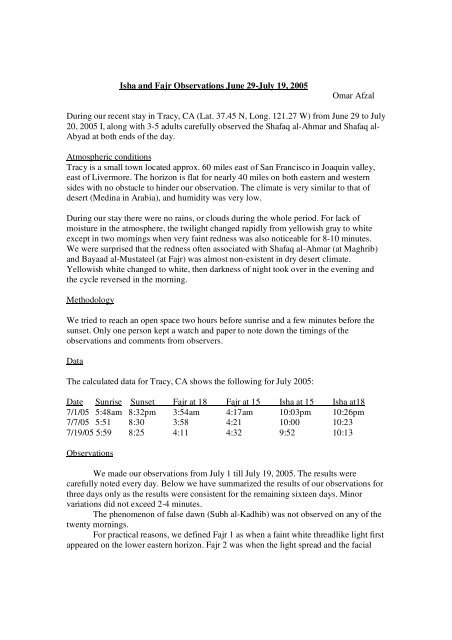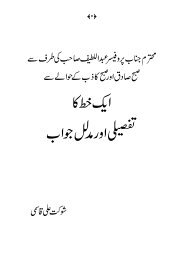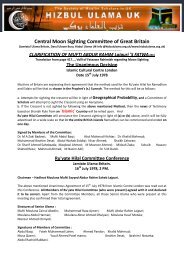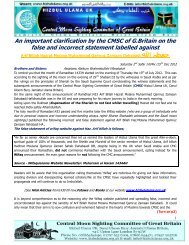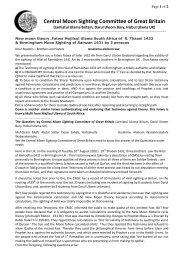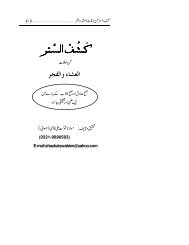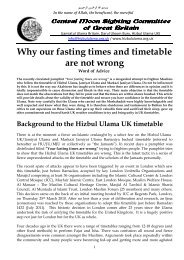article on Fajar and Isha observations by Dr ... - Hizbul Ulama UK
article on Fajar and Isha observations by Dr ... - Hizbul Ulama UK
article on Fajar and Isha observations by Dr ... - Hizbul Ulama UK
Create successful ePaper yourself
Turn your PDF publications into a flip-book with our unique Google optimized e-Paper software.
<strong>Isha</strong> <strong>and</strong> Fajr Observati<strong>on</strong>s June 29-July 19, 2005<br />
Omar Afzal<br />
During our recent stay in Tracy, CA (Lat. 37.45 N, L<strong>on</strong>g. 121.27 W) from June 29 to July<br />
20, 2005 I, al<strong>on</strong>g with 3-5 adults carefully observed the Shafaq al-Ahmar <strong>and</strong> Shafaq al-<br />
A<strong>by</strong>ad at both ends of the day.<br />
Atmospheric c<strong>on</strong>diti<strong>on</strong>s<br />
Tracy is a small town located approx. 60 miles east of San Francisco in Joaquin valley,<br />
east of Livermore. The horiz<strong>on</strong> is flat for nearly 40 miles <strong>on</strong> both eastern <strong>and</strong> western<br />
sides with no obstacle to hinder our observati<strong>on</strong>. The climate is very similar to that of<br />
desert (Medina in Arabia), <strong>and</strong> humidity was very low.<br />
During our stay there were no rains, or clouds during the whole period. For lack of<br />
moisture in the atmosphere, the twilight changed rapidly from yellowish gray to white<br />
except in two mornings when very faint redness was also noticeable for 8-10 minutes.<br />
We were surprised that the redness often associated with Shafaq al-Ahmar (at Maghrib)<br />
<strong>and</strong> Bayaad al-Mustateel (at Fajr) was almost n<strong>on</strong>-existent in dry desert climate.<br />
Yellowish white changed to white, then darkness of night took over in the evening <strong>and</strong><br />
the cycle reversed in the morning.<br />
Methodology<br />
We tried to reach an open space two hours before sunrise <strong>and</strong> a few minutes before the<br />
sunset. Only <strong>on</strong>e pers<strong>on</strong> kept a watch <strong>and</strong> paper to note down the timings of the<br />
observati<strong>on</strong>s <strong>and</strong> comments from observers.<br />
Data<br />
The calculated data for Tracy, CA shows the following for July 2005:<br />
Date Sunrise Sunset Fajr at 18 Fajr at 15 <strong>Isha</strong> at 15 <strong>Isha</strong> at18<br />
7/1/05 5:48am 8:32pm 3:54am 4:17am 10:03pm 10:26pm<br />
7/7/05 5:51 8:30 3:58 4:21 10:00 10:23<br />
7/19/05 5:59 8:25 4:11 4:32 9:52 10:13<br />
Observati<strong>on</strong>s<br />
We made our observati<strong>on</strong>s from July 1 till July 19, 2005. The results were<br />
carefully noted every day. Below we have summarized the results of our observati<strong>on</strong>s for<br />
three days <strong>on</strong>ly as the results were c<strong>on</strong>sistent for the remaining sixteen days. Minor<br />
variati<strong>on</strong>s did not exceed 2-4 minutes.<br />
The phenomen<strong>on</strong> of false dawn (Subh al-Kadhib) was not observed <strong>on</strong> any of the<br />
twenty mornings.<br />
For practical reas<strong>on</strong>s, we defined Fajr 1 as when a faint white threadlike light first<br />
appeared <strong>on</strong> the lower eastern horiz<strong>on</strong>. Fajr 2 was when the light spread <strong>and</strong> the facial
features of a pers<strong>on</strong> st<strong>and</strong>ing some 10-12 feet away could be recognized. Fajr 3<br />
(Tabayyan) followed 8-10 minutes later when the light spread over the entire eastern<br />
horiz<strong>on</strong> <strong>and</strong> is not tabulated.<br />
In the evening, bright light was quite intense after sunset <strong>and</strong> covered the entire<br />
western horiz<strong>on</strong>. It lost its intensity 20-25 minutes later, <strong>and</strong> narrowed until a yellowish<br />
threadlike streak with a peak at the center remained for the next 12-15.(This is what we<br />
put as <strong>Isha</strong> 1.) Because of lack of moisture <strong>and</strong> dust p<str<strong>on</strong>g>article</str<strong>on</strong>g>s no redness was ever<br />
observed. The yellowish narrow white streak <strong>on</strong> the lowest horiz<strong>on</strong> disappeared<br />
completely at <strong>Isha</strong> 2, making the entire sky dark.<br />
One of us also first observed a very thin Jumada II crescent mo<strong>on</strong> <strong>on</strong> July 7, at<br />
8:47 pm some 12 minutes after the sunset in an extremely clear sky. Others were able to<br />
see it three to four minutes later.<br />
Date Sunrise Fajr1 Fajr 2 Sunset <strong>Isha</strong> 1 <strong>Isha</strong> 2<br />
7/1/05 5:48am 4:54am 5:17am 8:32 9:12pm 9:29pm<br />
7/7/05 5:51 4:56 5:21 8:30 9:11 9:27<br />
7/19/05 5:59 5:02 5:23 8:25 9:08 9:19<br />
Two observers who never participated earlier in naked-eye observati<strong>on</strong>s of the<br />
phenomen<strong>on</strong> observed Fajr 1 some 3-5 minutes later. Similarly, for <strong>Isha</strong> 2, they claimed<br />
the sky was dark a few minutes earlier.<br />
In the last week of the observati<strong>on</strong>al period we also made rough sketches of the sky<br />
brightness at various stages.<br />
C<strong>on</strong>clusi<strong>on</strong>s<br />
Our observati<strong>on</strong>s c<strong>on</strong>firmed that in Medina during the time of the earliest Islamic<br />
community the quantifying process for the prayer schedule was dependent <strong>on</strong><br />
atmospheric c<strong>on</strong>diti<strong>on</strong>s at Fajr <strong>and</strong> ‘Utama for <strong>Isha</strong>.<br />
In Medina, a small desert town, lack of moisture in the atmosphere made twilights<br />
shorter. Hence Fajr prayers were held closer to sunrise <strong>and</strong> <strong>Isha</strong> closer to the sunset. The<br />
Qur’anic use of the two terms <strong>and</strong> practices reported in Ahadith (Afzal et. al 1993) point<br />
in the same directi<strong>on</strong>.<br />
Later, Muslim time-keepers (Muwaqqiteen) in Syria tried to use Greek astr<strong>on</strong>omical<br />
terms for Fajr <strong>and</strong> <strong>Isha</strong>. Ultimately, various Fiqh positi<strong>on</strong>s tied Fajr <strong>and</strong> <strong>Isha</strong> in later half<br />
of the twentieth century to the sun’s depressi<strong>on</strong> in higher latitudes. The variati<strong>on</strong> is the<br />
length of Shafaq (twilight) is enormous from 39 minutes to two <strong>and</strong> half hours in<br />
temperate climates <strong>and</strong> very unusual above 48 degrees latitudes.<br />
A summary of our earlier research <strong>on</strong> the topic of <strong>Isha</strong> <strong>and</strong> Fajr times is reproduced<br />
below. Our observati<strong>on</strong>s at Tracy, California str<strong>on</strong>gly support our c<strong>on</strong>clusi<strong>on</strong>s.<br />
C<strong>on</strong>clusi<strong>on</strong>s
Ludhianvi’s discussi<strong>on</strong> of Shafaq <strong>and</strong> Subh al-Sadiq were limited to the evaluati<strong>on</strong> of<br />
Fiqh arguments, <strong>and</strong> a few naked eye observati<strong>on</strong>s. He did not have access to the data<br />
accumulated between 1950s <strong>and</strong> 1990s through physical observati<strong>on</strong>s <strong>and</strong> instrumental<br />
measurements. Meinel included dozens of colored photographs of the evening sky used<br />
in his research. Rosenberg’s “Twilight” c<strong>on</strong>tains very valuable data. Astr<strong>on</strong>omical<br />
journals have published hundreds of detailed photographs of twilights, Zodiacal lights,<br />
<strong>and</strong> other related phenomena that we used in this study. We have present the results of<br />
our findings for the c<strong>on</strong>siderati<strong>on</strong> of the Ummah.<br />
There is a c<strong>on</strong>sensus that Fajr al-Mustatir/Imsak begins at Subh Sadiq/Fajr Thani, <strong>and</strong><br />
<strong>Isha</strong> begins when Shafaq disappears. From the discussi<strong>on</strong>s presented in the paper it is<br />
quite obvious that Subh al-Sadiq <strong>and</strong> end of Shafaq cannot be tied to the astr<strong>on</strong>omical<br />
twilight (108° sun's depressi<strong>on</strong> from zenith, technical “night”). A more uniform global<br />
prayer schedule with an excepti<strong>on</strong>ally small ‘exempt’ regi<strong>on</strong> may be prepared,<br />
without violating the guidelines of the Qur'an <strong>and</strong> the Sunnah, if 13.8 degrees for<br />
Fajr <strong>and</strong> 8-10 degrees sun’s azimuth distance for <strong>Isha</strong> is accepted as the global<br />
norm. We argue that:<br />
1. Islam's universality <strong>and</strong> 'ease' require a broader interpretati<strong>on</strong> of Fajr <strong>and</strong><br />
Shafaq, instead of a narrow <strong>and</strong> stringent reading.<br />
2. Prayer schedules prepared <strong>on</strong> the basis of 108°/105° create undue hardship<br />
<strong>and</strong> result in very large "exempt" z<strong>on</strong>es. All proposed soluti<strong>on</strong>s lack the<br />
c<strong>on</strong>sistency.<br />
3. Physical observati<strong>on</strong>s <strong>and</strong> instrumental measurements both support this<br />
positi<strong>on</strong>.<br />
Technically the astr<strong>on</strong>omical twilight (18 degrees) is "night". Instrumental<br />
measurements taken over an extensive period c<strong>on</strong>clude that the intensity of light between<br />
103.5° to 108° remains almost the same. The beginning of the red glow (Shafaq), spread<br />
over the entire horiz<strong>on</strong>, <strong>and</strong> slowly narrowing to a narrow b<strong>and</strong> appears to be closest to<br />
the words <strong>and</strong> intent of the Qur'an, the Sunnah, the practices of the Compani<strong>on</strong>s, <strong>and</strong> the<br />
positi<strong>on</strong> of most of Fuqaha. Instrumental measurements show that this level of<br />
illuminati<strong>on</strong> for Fajr <strong>and</strong> <strong>Isha</strong> may be reached in 40-60 minutes at almost all places of the<br />
globe where this phenomen<strong>on</strong> occurs daily. If the Shafaq is broadly defined then in<br />
tropical regi<strong>on</strong>s the delay is another 10-15 minutes. But in higher latitudes the whiteness<br />
does not diminish for hours l<strong>on</strong>g after the sun has reached 18 degrees below the horiz<strong>on</strong>.<br />
For m<strong>on</strong>ths, the level of illuminati<strong>on</strong> in areas above 40 degree northern latitudes does not<br />
reach to the level of darkness at night (108°) in temperate climates.<br />
Islam is for all mankind living in all corners of the world <strong>and</strong> for all times. It came to<br />
make human life easy <strong>and</strong> harm<strong>on</strong>ious. Allah's intent is never to burden humans with<br />
cruel <strong>and</strong> stringent rules that choke normal human activities. Civil night starts/ends at<br />
96° when normal outside activities cease/begin without the help of artificial light. In<br />
Medinah at the time of Messenger (SAW) this appears to be the natural limit of the daily<br />
activities. Also Yatabayyana of the Qur'an seems closer to 96°, because at 102° the sea<br />
horiz<strong>on</strong>, in general, is not visible <strong>and</strong> it is too dark for the observati<strong>on</strong> of an altitude with<br />
reference to the horiz<strong>on</strong>.
Allah in His infinite mercy has made matters easy for us <strong>and</strong> His Messenger (SAW) <strong>and</strong><br />
Sahaba exemplified His guidelines. The Fuqaha did not specify 108° for Fajr <strong>and</strong> <strong>Isha</strong>.<br />
If some <strong>Ulama</strong> have lately accepted the astr<strong>on</strong>omical twilight (108°) as limits of Fajr <strong>and</strong><br />
<strong>Isha</strong>, because of their cautious attitude, <strong>and</strong> limited knowledge of physical realities we do<br />
not have to close our eyes, <strong>and</strong> reject very str<strong>on</strong>g arguments which point in the other<br />
directi<strong>on</strong>.<br />
By inflicting hardship to our bodies we are not pleasing Allah a little more. Islam is a<br />
religi<strong>on</strong> of Qist (middle) <strong>and</strong> not of extremes. In the tropical climate a difference of 2.5°<br />
is equivalent to <strong>on</strong>ly 12-15 minutes, but in higher latitudes it means adding 25-60 minutes<br />
at both ends of the day <strong>and</strong> night. For L<strong>on</strong>d<strong>on</strong> <strong>and</strong> Glasgow, the days become too l<strong>on</strong>g.<br />
Asking a 10-12year old child or a 60-65 year old pers<strong>on</strong>, or those who earn their living in<br />
jobs requiring physical labor, to fast 17-22 hours does not appear to be the intent of<br />
Islam.We would like to propose the following quantificati<strong>on</strong> of Fajr <strong>and</strong> Shafaq, in the<br />
light of c<strong>on</strong>vergence of the Qur'an, Sunnah, Fiqh, <strong>and</strong> the instrumental measurements of<br />
the intensity of light.<br />
A word of cauti<strong>on</strong> may be helpful to the readers regarding our attempt to rec<strong>on</strong>cile the<br />
textual readings of the Qur'an <strong>and</strong> Ahadith as well as opini<strong>on</strong>s (Fatawa) of the Fuqaha<br />
with the scientific overview <strong>on</strong> a subject matter that eluded precise descripti<strong>on</strong> for<br />
centuries. The thread that ties various secti<strong>on</strong>s of this paper together is our earnest desire<br />
to relate our growing awareness of the global aspect of sky's brightness with the prayer<br />
times. In various parts of the world the sky's brightness is drastically different from the<br />
tropical climates where most of the Muslims were c<strong>on</strong>centrated for the last 14 centuries.<br />
In tropical climate it changes very rapidly, <strong>and</strong> the <strong>Ulama</strong> being overcautious pushed<br />
Fajr <strong>and</strong> <strong>Isha</strong> to the extreme limits of the calculated night. Most of the attempts during<br />
the last 50 years or so were unable to achieve a c<strong>on</strong>sensus because the observati<strong>on</strong>s in<br />
various studies were not c<strong>on</strong>sistent. Not <strong>on</strong>ly they lacked any scientific validity but were<br />
very limited <strong>and</strong> unreliable. Almost all of them were made to justify a positi<strong>on</strong> rather<br />
than opting for a positi<strong>on</strong> based <strong>on</strong> them.<br />
Sun from zenith Arabic terminology Phenomen<strong>on</strong><br />
Morning 103.5° to 108° Lail Night<br />
103.5° Fajr al-Mustatil False dawn<br />
100° to 102° Fajr al-Mustatir True dawn<br />
98° Isfar<br />
90.833° Tulu' Shams, Shurooq Sunrise<br />
Evening 90.833° Ghuroob Shams, Maghrib Sunset<br />
98° Shafaq Ahmer (<strong>Isha</strong> Shafi'i) Redness ends<br />
100° to 102° Shafaq A<strong>by</strong>ad (<strong>Isha</strong> Hanafi) Whiteness ends<br />
103.5° to 108° Lail Night<br />
These sun's positi<strong>on</strong>s may be correlated graphically in Figure 4 which is a reproducti<strong>on</strong><br />
of Figure 3 with the above proposals.
Figure 4<br />
Brightness of the twilight sky at the zenith as a functi<strong>on</strong> of<br />
the sun's zenith angle for measurements <strong>on</strong> 32 evenings,<br />
with l = 0.63 m.<br />
This paper is written for the <strong>Ulama</strong>, <strong>and</strong> for the inquisitive people. We hope that in the<br />
spirit of this paper all of our readers will be open, <strong>and</strong> find a pleasant way to learn<br />
fascinating facts of nature which the Islamic traditi<strong>on</strong>s incorporated in the day to day life<br />
of the Muslims. Urdu <strong>and</strong> Arabic versi<strong>on</strong>s of this paper will Insha-Allah, be available<br />
so<strong>on</strong>. Please c<strong>on</strong>vey your comments <strong>and</strong> opini<strong>on</strong>s to CFCO 1069 Ellis Hollow Rd. Ithaca<br />
NY 14850 USA or oa12@cornell.edu<br />
Appendix 1<br />
Zodiacal lights<br />
The Gazette (M<strong>on</strong>treal, Quebec) March 1, 2003 Saturday ANDREW S. FAZEKAS 810 words<br />
HEADLINE: Seeing an elusive light in spring: Zodiacal light can look like the lights of a<br />
far-off city just over a dark horiz<strong>on</strong> in the countryside. But this light is more ethereal;<br />
it is caused <strong>by</strong> sunlight reflecting off cosmic dust between the planets<br />
For a few weeks each year, keen-eyed skywatchers have a chance to glimpse something<br />
special. It is something so elusive that it has become more of a myth than reality in today's<br />
light-polluted world. When winter's grip begins to lessen <strong>and</strong> the days get l<strong>on</strong>ger, it is time to<br />
sweep the heavens for a celestial spectacle known as the zodiacal light.<br />
Around springtime, it occurs as a strange, diffuse c<strong>on</strong>e of light reaching up from the western<br />
horiz<strong>on</strong> just after sunset, looking a bit like the lights of a far-off city just over the horiz<strong>on</strong>.<br />
(In fall, it can be seen just before dawn in the east.)<br />
Many of us have probably mistaken this eerie faint glow for just that while driving westward<br />
after the sun has g<strong>on</strong>e down. Unlike the famous aurora displays formed in Earth's upper<br />
atmosphere or the b<strong>and</strong> of the Milky Way located light years away, the source of the<br />
zodiacal light lies in our solar system, between the planets.<br />
Orbiting the sun are billi<strong>on</strong>s of tiny sub-millimetre-size dust p<str<strong>on</strong>g>article</str<strong>on</strong>g>s that reflect <strong>and</strong> scatter<br />
sunlight in such a way that they are visible in our sky - much as we see household dust<br />
floating in fr<strong>on</strong>t of a sunny window. C<strong>on</strong>centrated in the inner solar system, most of this<br />
space debris is being c<strong>on</strong>stantly generated from asteroid collisi<strong>on</strong>s <strong>and</strong> the leftovers from<br />
comets as their orbits have taken them around the sun.<br />
In observing zodiacal light, skywatchers are actually witnessing the ancient rubble from the<br />
birth of our solar system more than 4.5 billi<strong>on</strong> years ago.<br />
Like a delicate necklace surrounding the sun, this cosmic dust cloud that makes up zodiacal<br />
light lies mostly al<strong>on</strong>g the flat disk of the solar system. The ancient Greek astr<strong>on</strong>omers took<br />
notice of a b<strong>and</strong> of 12 c<strong>on</strong>stellati<strong>on</strong>s that are <strong>on</strong> the same plane as the solar system <strong>and</strong> are<br />
seen from Earth as our planet orbits the sun. They called these c<strong>on</strong>stellati<strong>on</strong>s the zodiac,<br />
meaning "circle" in Greek. This is the origin of the famous zodiac signs used in horoscopes.<br />
Zodiacal light can be seen looming in the west al<strong>on</strong>g the same plane as the planets <strong>and</strong> the
zodiac c<strong>on</strong>stellati<strong>on</strong>s, hence its name. Its subtle radiance is most noticeable around the<br />
spring <strong>and</strong> fall equinoxes.<br />
Known <strong>and</strong> sometimes feared since ancient times, zodiacal light was recorded <strong>by</strong> many<br />
cultures. The Greek philosopher Aristotle c<strong>on</strong>cluded that these misty patches of lights in the<br />
heavens were caused <strong>by</strong> far-off volcanic erupti<strong>on</strong>s. First-century Romans likened them to the<br />
glows of distant unseen fires.<br />
In the 16th century, they were a more ominous associati<strong>on</strong> for the Aztec Empire <strong>and</strong> its ruler,<br />
M<strong>on</strong>tezuma. The king gave up his empire to Cortes <strong>and</strong> his army of Spanish c<strong>on</strong>quistadors in<br />
1519, in part because of the strange appearance of the ghostly pyramid-shaped light that<br />
M<strong>on</strong>tezuma described as a threatening "vast flood of sparkling fire."<br />
The night skies aren't totally dark. At times, sunlight or mo<strong>on</strong>light reflects off high-altitude<br />
clouds, causing a degree of brightness in the starry skies. And dark locati<strong>on</strong>s still offer<br />
glorious views of a b<strong>and</strong> of light running across the overhead sky. This is actually the light<br />
from billi<strong>on</strong>s of stars that make up our own Milky Way galaxy.<br />
But in fact, about 40 per cent of the overall light in the night sky can be attributed to this<br />
zodiacal dust cloud. Sometimes known as the "afterglow of the day," it is often c<strong>on</strong>fused<br />
with twilight, which uniformly encompasses most of the western sky.<br />
Few people today have c<strong>on</strong>sciously observed this astr<strong>on</strong>omical phenomen<strong>on</strong>, mainly because<br />
it is necessary to be well away from city lights to have a chance to see it. At best, zodiacal<br />
light can equal the brightness of the Milky Way, so even the slightest hint of haze in the<br />
atmosphere or light polluti<strong>on</strong> can hide it from view. Despite its faintness, it can take up a<br />
surprisingly big piece of the sky, equivalent to about two fists stacked <strong>on</strong> top of each other,<br />
held at arm's length.<br />
March is the best time of the year to look for the evening zodiacal light. Choose a really<br />
dark site about an hour after sunset <strong>by</strong> escaping the c<strong>on</strong>fines of the city <strong>and</strong> suburbs <strong>and</strong><br />
heading out to the country, particularly <strong>on</strong> a mo<strong>on</strong>less night. Bearing in mind that the display<br />
is named for the zodiac, at this time of the year it will be highlighting the part of the sky<br />
occupied <strong>by</strong> the c<strong>on</strong>stellati<strong>on</strong>s Pisces, Aries <strong>and</strong> Taurus.<br />
Next time you are out <strong>on</strong> a mo<strong>on</strong>less March night, try to glimpse the elusive glow of the<br />
zodiacal light. For those who are less adventurous, just think of the zodiacal light the next<br />
time you dust around the home, <strong>and</strong> thank your lucky stars you d<strong>on</strong>'t have to clean the solar<br />
system - it's full of dust!<br />
Andrew S. Fazekas is teaching an introductory stargazing course <strong>on</strong> Tuesday evenings at<br />
Vanier College starting March 25. For more informati<strong>on</strong>, call (514) 744-7000 or visit<br />
www.<strong>and</strong>rewfazekas.com skyfeedback@hotmail.com<br />
GRAPHIC: Color Photo: DOMINIC CANTIN, FREELANCE; A faint c<strong>on</strong>e-shaped glow of<br />
zodiacal light lights the western evening sky in March. Dominic Cantin, an amateur<br />
astr<strong>on</strong>omer from Quebec City, took the photo above with a 35-mm camera <strong>and</strong> wide-angle<br />
lens. For a three-minute exposure, Cantin used a motor (hence the angled horiz<strong>on</strong>) to<br />
compensate for the Earth's rotati<strong>on</strong>.<br />
--<br />
Criteria for Correct time of Subh e Sadiq -- C<strong>on</strong>sensus of Muftian Kiram of Pakistan<br />
English rendering of the <str<strong>on</strong>g>article</str<strong>on</strong>g> published in the daily Nawai Waqt <strong>on</strong> 17.08.2009<br />
By: Engr Malik Bashir Ahmad Bagvi, Islamabad<br />
(English versi<strong>on</strong> of the <str<strong>on</strong>g>article</str<strong>on</strong>g> published in daily Nawai Waqt, Islamabad dated 17.08.2009)<br />
1. So<strong>on</strong> we will be starting fasting in the m<strong>on</strong>th of Ramadan. In this c<strong>on</strong>text , through your esteemed paper<br />
I want to draw the attenti<strong>on</strong> of those publishing Sehr wa Iftartime schedule <strong>and</strong> the public at large, towards
an important point According to authentic Aahadis, Subhe Sadiq (True dawn) is the light appearing<br />
before sunrise, which is spread horiz<strong>on</strong>tally from south to north. Another light appearing just before Subhe<br />
sadiq has also been menti<strong>on</strong>ed with the same authenticity, which is called Subhe kazib (false dawn). The<br />
Holy Prophet (pbuh) said: Do not care for the Subh e Kazib. C<strong>on</strong>tinue your sehri till Subhe Sadiq, because<br />
closing fast late is preferable, while Fajr prayers must be offered after Subh e Sadiq<br />
2. Subh e Kazib is a pyramid shaped vertical light. According to the informati<strong>on</strong> received from the<br />
Pakistan Navy, from midnight <strong>on</strong>ward, there is complete darkness till before Fajr time given in the prayer<br />
time schedule in use in Pakistan, .C<strong>on</strong>sequently the Fajr time given in these charts is in fact the time of<br />
Subh e Kazib. Every publicati<strong>on</strong> bears the name of its author, whereas the man behind to introduce this<br />
chart in Pakistan has no trace in the back history. However <strong>on</strong>e or two odd pers<strong>on</strong>s (not ulema) came<br />
forward to defend it <strong>by</strong> arguing that baruji roshani (zodiacal light), appearing l<strong>on</strong>g before sunrise was the<br />
subhe kazib, which the scientists name as false dawn<br />
3. According to Almanac, (a famous book providing astr<strong>on</strong>omical data), zodiacal<br />
light appears <strong>on</strong>ly for two m<strong>on</strong>ths in a year--- mid of Aug to mid of Oct, <strong>and</strong> that too l<strong>on</strong>g before<br />
sunrise/Subhe Sadiq. When checked <strong>by</strong> the criteria provided <strong>by</strong> the relevant Ahadis, from Shari'ah view<br />
point, zodiacal light has nothing to do with Subh e Kazib. The Shari'ah requirement is that, Subh e Kazib<br />
a. Should appear <strong>on</strong> the eastern horiz<strong>on</strong> every day<br />
b. It should be very close to Subh e Sadiq<br />
Hence he time given in the current charts is in fact the 1st regularl light after mid night <strong>and</strong> so it is the<br />
Subh e kazib. According to Shami (a famous book of Fiqh), there is an angular vertical distance of 3<br />
degrees between Subh e Sadiq <strong>and</strong> Subh e Kazib. In Pakistan this corresp<strong>on</strong>ds to a time gap of 16-20<br />
minutes from Karachi (25N LAT) to Peshawar (24N LAT), during the whole year.<br />
4. In this c<strong>on</strong>text we approached ten (10) top ranking darul ifta, <strong>and</strong> they categorically <strong>and</strong> without<br />
excepti<strong>on</strong> rejected the idea of accepting zodiacal light as the Subh e Kazib, <strong>and</strong> thus c<strong>on</strong>firmed that the<br />
Fajr time in these charts is in fact the time of Subh e Kazib <strong>and</strong> that the Subh e Sadiq will appear later <strong>by</strong><br />
some minutes. These darul ifta are:<br />
1. Darul Olum Karachi<br />
2. Mufti Munibur Rahman, Chairman Central Roet e Halal Committee<br />
3. Jamia Usmania, Peshawar<br />
4. Darul Olum Haqqania, Akora Khatak<br />
5. Jamia Faruqia, Karachi<br />
6. Jamia tur rasheed, Karachi<br />
7. Darul Olum Ta'leem ul Quran, Rawalpindi<br />
8. Jamia faridia, Islamabad<br />
9. Jamia Islamia Banauri Town, Karachi<br />
10. Imdad ul Olum Karachi<br />
All these fatawa are c<strong>on</strong>tained in the prayer chart for Islamabad/ Rawalpindi available from Jamae<br />
Masjid Bilal Habshi,Ghazi Abad, Dhok Syedan, Rawalpindi (mobile: 0346 5282 460/ 0300 5391 850)<br />
5. Thirty-two eminent ulama kiram of Rawalpndi <strong>and</strong> Islamabad have shown their full c<strong>on</strong>fidence<br />
<strong>on</strong> these fatawa. Some of these are:<br />
a. Jamia Rizvia Zia ul Olum Rawalpindi-Maulana <strong>Isha</strong>q Zafar<br />
b. Markazi Jamae Masjid Rawalpindi- Divisi<strong>on</strong>al Khatib Maulana Ghulam Ali Qamar<br />
c. Jamia Furqania Rawalpindi- Maulana Abdul Majid Hazarvi<br />
d. Masjid Tauhid Ahle Hadis Islamabad-<strong>Dr</strong> Suhail Hasan<br />
e. Jamae Masjid Mo'tamir Alam e Islami Islamabad- Qazi Zain ul Abedin<br />
6. Just as a prayer is invalid without wuzu, it is invalid if offered before the prescribed time.<br />
Therefore if the media including Radio Pakistan <strong>and</strong> PTV announce the sehr wa iftar time as per schedule<br />
prepared <strong>by</strong> me (based <strong>on</strong> 15 deg depressi<strong>on</strong> of sun below horiz<strong>on</strong> for Fajr), it will help people save their<br />
farz prayer from going waste, in the sacred m<strong>on</strong>th of Ramadan, when the tendency is to offer Fajr prayer
the earliest after closing sehri. The Survey of Pakistan <strong>and</strong> the MET dept of Pakistan have c<strong>on</strong>firmed that<br />
my chart is full in agreement with the fatawa.<br />
7. According to Imam Abu Yusuf, azan for Fajr can be called before time. Mufti Rashid Ahmad<br />
Ludhianvi had instructed the mo'azzan of his mosque to st<strong>and</strong> up <strong>on</strong>e minute before time for azan, so that<br />
<strong>on</strong>e could swallow the morsel in his mouth or drink a glass of water. We have extended this interval to<br />
three minutes to play safe for close of sehri. It takes 2-3 minutes to finish azan. And so <strong>by</strong> the time the azan<br />
is finished, Fajr time will have started. As such, people will not be tempted to offer Sunna before time.<br />
Similarly, women folk who are not to wait for the c<strong>on</strong>gregati<strong>on</strong>, shall not offer farz prayers before time.<br />
Note: a computer software in EXCEL prepared <strong>by</strong> this writer is available free of cost through emai., Using<br />
it <strong>on</strong>e can prepare sehr wa iftar/ 100-years prayer time schedule for any tow of known latitude <strong>and</strong><br />
l<strong>on</strong>gitude. Such data for more than 6,000 towns of Pakistan has already been in-built in the package.<br />
Engr Malik Bashir Ahmad Bagvi, Islamabad 0300 5032 566


